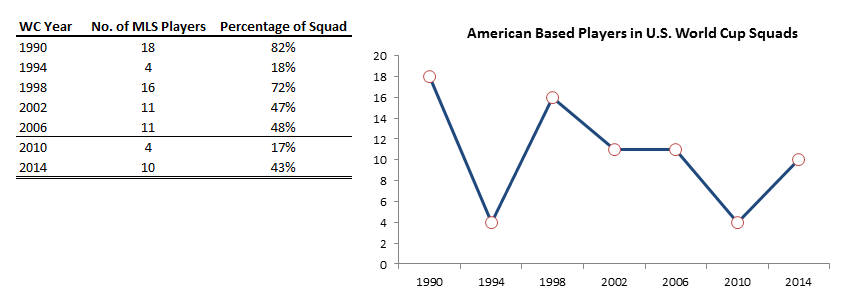The Economist newspaper carries a range of thought provoking articles concerning the ‘beautiful game – ugly business’ this week that can be accessed here, here and is most thoroughly featured here. In the last of these three articles, a briefing called ‘A Game of Two Halves’ many claims are made – some of which I agree with, others which I do not. Luckily for me we can actually collect data to see whether one claim (I doubted) is correct.
Suggesting that the soccer in the U.S is growing in status the newspaper says that:
“According to Forbes magazine, the average MLS franchise is now worth $103m, up more than 175% over the past five years. The league had 13 clubs in 2007; next year it will have 21, including a new club in New York. The improved MLS has lured America’s best players, like Mr Dempsey and Michael Bradley, back from the European leagues. There are ten players from MLS teams in this year’s American squad; there were just four in 2010.” (pg.24 - European Print Edition)
It is fair to make inference from citing the Forbes report, arguable (opinion) that messrs Dempsey and Bradley returned to the U.S due to the ‘lure of the MLS’ but inaccurate to draw inference on the MLS’s popularity using the metric of home based players in the American squad. It is here that the newspaper is selective with the evidence – why not include the number of American based players in the 1990, 1994, 1998, 2002 and 2006 squads also? Surely if the number of American based players in their squad was a proximate measure for soccers status as a sport in the U.S the number of home based players in these earlier World Cups would have also been low?
The table and chart below suggests otherwise. If we collect more data and look at U.S squads in World Cups since 1990 (the last time the U.S played in a World Cup before then was 1950), with the exception of 1994, when ironically the competition was hosted in the U.S, there has actually been a downward trend in the number of American based players in the squad.
While not arguing against the point that soccer in the U.S is growing in status, using metrics such as the number of home based players in the U.S squad is not a good measure to gauge the development of the beautiful game stateside.

 RSS Feed
RSS Feed